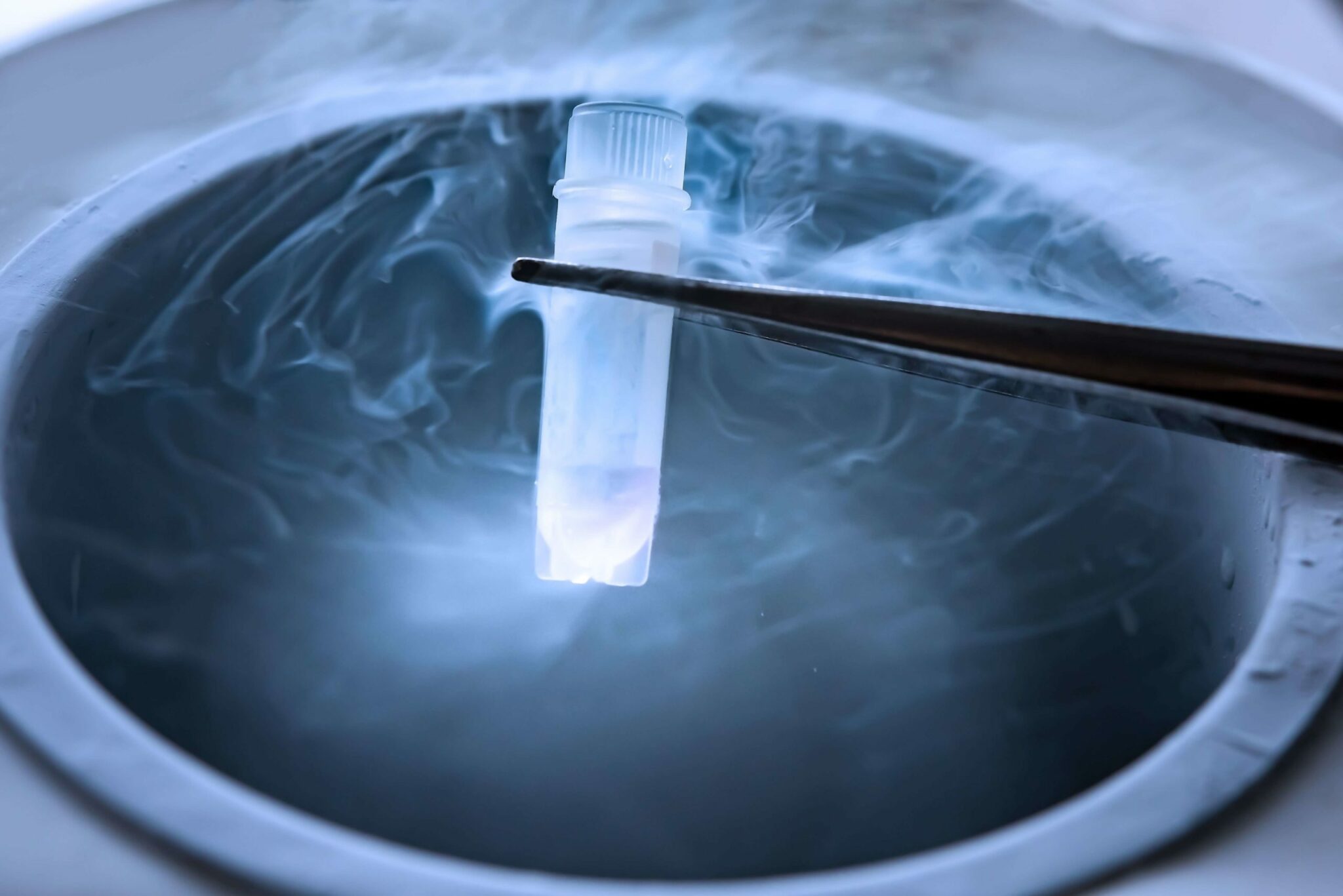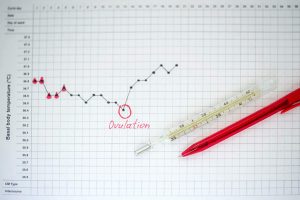تجميد أنسجة المبيض: هل يُمكن استخدام هذه التقنية لتأخير سن الأمل؟

The freezing of ovarian tissue, also known as Ovarian Tissue Cryopreservation (OTC), is an experimental type of fertility preservation, used predominantly by female cancer patients who would otherwise likely become infertile following treatment.
How is OTC performed?
Part or all of the ovary is removed using laparoscopy. If the entire ovary is removed it may be cryopreserved whole, otherwise it is cut into very thin slices, between 0.3 and 2mm, which are frozen and stored until required. The tissue is thawed and re-transplanted, either into the pelvic region (orthotopic) or elsewhere in the body (heterotopic).
Part vs whole ovary?
It is not always necessary to remove the whole ovary, although your doctor might choose to if they anticipate complete ovarian failure. Often only the outer layer will be taken, this is known as the ovarian cortex. There are a large number of immature eggs (oocytes) located in primordial follicles in this part of the ovary. This means that taking a small volume of tissue could potentially provide hundreds of oocytes for subsequent fertility treatment.
The advantage of taking the whole ovary is that there is less chance of tissue ischemia (where the blood supply is decreased, resulting in reduced oxygen supply to the tissue), as blood flow can be maintained, or rapidly restored (revascularisation), using the vascular pedicle. Following re-transplantation, the vascular pedicle ensures adequate oxygenation of the transplanted tissue, reducing the likelihood of transplant failure. However, there can be challenges with cryopreserving it in its entirety and, if anything goes wrong, survival of the entire ovary could be compromised.
Slow freezing vs vitrification?
Work to establish the optimal method of freezing resected ovarian tissue is on-going. The most widely used method is the slow freezing of the tissue in a step-by-step process until it reaches -140°C, at which point it is stored in liquid nitrogen. Slow freezing reduces the formation of ice crystals, which can damage the ovarian cells. Vitrification is a newer technique that uses ultra-fast cooling with a higher concentration of cryoprotectant. It is quick and relatively easy to perform, with no requirement for expensive equipment. However, so far it is not widely used and there is limited data on its effectiveness.
Orthotopic vs heterotopic
Determining the best transplant site for your cryopreserved ovarian tissue largely depends on your reason for undergoing OTC. If you hope to fall pregnant naturally, your only option is to undergo an orthotopic transplant. In this procedure the cryopreserved ovarian tissue is transplanted back into the pelvic region. Strips of tissue are transplanted either onto the surface of the remaining ovary, or into the pelvic peritoneum. The close proximity to the fallopian tubes means natural pregnancy is possible. However, the size of the transplant site restricts the number of fragments that can be transplanted. Menstrual cycles typically resume 4-9 months after OTC, which aligns closely with the time it takes for normal follicular growth and oocyte maturity. This suggests that following OTC and re-transplantation the ovarian eggs start to develop normally. The lifespan of transplanted ovarian grafts is variable, the longest to date has been seven years.
During a heterotopic transplant the ovarian tissue is re-transplanted elsewhere in the body. Frequently used sites are the forearm, abdomen wall and chest wall. Provided the transplant is successful, the transplanted ovarian tissue should start to produce hormones again, minimising any unwanted menopausal symptoms; however, pregnancy will only be possible using egg retrieval processes and artificial reproductive techniques/technologies (ARTs). The advantage to this type of transplant is that the graft can be placed in a location that allows for ease of access, so that maturing follicles can be monitored and retrieved if required for IVF and the transplanted tissue can be checked for signs of cancer recurrence. Aside from the fact that natural pregnancy is not possible following this type of transplant, the main disadvantage is that the transplanted tissue is less likely to survive due to difficulties reestablishing a blood supply.
Benefits to OTC
For those women facing sudden, unexpected or premature ovarian failure, OTC provides an option for maintenance of fertility. Unlike embryo or egg freezing, where a complex harvesting process yields a “normal range” of 8-15 eggs per procedure; removing the ovarian cortex results in the harvesting of hundreds to thousands of immature oocytes. Furthermore, it is a simpler process, there is no need to wait for a particular time in the cycle and therefore, the procedure can be performed with minimal notice period. The additional benefit to this is that any cancer treatment is not delayed as a result.
OTC is the only fertility preserving option for girls who have not yet gone through puberty. This is because they do not yet have mature eggs to harvest directly.
Negatives to OTC
Despite its potential, to date, OTC remains an experimental procedure. It is not yet endorsed by the American Society for Reproductive Medicine as a fertility preserving technique. There is hope that with more robust data, it will become more widely implemented in the clinical setting.
There is a risk that re-transplanting grafted tissue will reintroduce unwanted malignancies. There is more chance of this with blood-borne cancers, such as the leukaemias.
Use of OTC for cancer patients
The nature of many types of cancer treatment means that they are toxic to germ cells. Whilst chemoradiotherapy often does an excellent job of killing malignant cells, it can have a quite catastrophic effect on other cells of the body too. Learning that you have cancer and are likely to be rendered infertile by the treatment you receive is a huge psychological hurdle to overcome. In fact, the National Institute of Clinical Excellence (NICE) guidelines from the UK state that fertility preservation should be a part of the management of all cancer patients.
OTC has the potential to be of significant benefit to those facing cancer-induced infertility. However, it might not just be a case of rectifying infertility. Ovarian failure and a sudden drop in oestrogen and progesterone production essentially places the body in a menopausal state. This triggers a range of symptoms that can be challenging to deal with both physically and emotionally, for example, hot flushes, difficulty sleeping, vaginal dryness and reduced libido. OTC following by orthotopic transplantation reestablishes normal ovarian activity in as many as 95% of cases. This has the potential to alleviate challenging menopausal symptoms, without the need to rely on hormone replacement therapy (HRT).
Alternative uses
OTC is most strongly associated with the restoration of fertility in those who need to undergo life-saving, ovary-toxic cancer treatment. However, it has other potential uses for those with benign disease, such as recurrent endometriosis and advanced ovarian torsion. It has the potential to be used prophylactically in those with a history of primary ovarian insufficiency (POI) or with auto-immune diseases.
There is also the option to use OTC as a means of postponing the menopause. With life expectancy increasing, it is now estimated that a high number of women will spend a significant proportion of their life post-menopause. There are certain risks associated with this from both a health and a quality of life perspective. Postmenopausal women are at greater risk of experiencing osteoporosis, cardiovascular disease and depression; and HRT is not suitable for everyone. Securely cryopreserving a large population of ovarian follicles, which when grafted back into the human body would start producing the female sex hormones, is one way to delay the onset of menopause. However, whilst the idea makes sense in theory, as an experimental procedure, OTC is not currently endorsed to be used in this way.
Current status
As described above, OTC has a lot of potential. So far the technique has resulted in more than 130 live births.
There are technical challenges still to overcome. The protocols for freezing the resected tissue need optimising because current methods result in a lot of empty follicles, possibly as a result of ice crystal formation. Improving the viability of the follicles would increase the lifespan of the grafted tissue.
There also needs to be further consideration of who could benefit from the procedure. Going forward, is this a feasible way of postponing the onset of the menopause for completely healthy women? Or, is it something that should be kept and optimised for use as a fertility preservation technique for those facing imminent, premature infertility?
It is best if you try Perimenopause test to understand more on your health.
Nabta is reshaping women’s healthcare. We support women with their personal health journeys, from everyday wellbeing to the uniquely female experiences of fertility, pregnancy, and menopause.
Get in touch if you have any questions about this article or any aspect of women’s health. We’re here for you.
Sources:
- Broekmans, Frank J. “Individualization of FSH Doses in Assisted Reproduction: Facts and Fiction.” Frontiers in Endocrinology, vol. 10, 26 Apr. 2019, doi:10.3389/fendo.2019.00181.
- Donnez, Jacques, and Marie-Madeleine Dolmans. “Fertility Preservation in Women.” New England Journal of Medicine, vol. 377, no. 17, 26 Oct. 2017, pp. 1657–1665., doi:10.1056/nejmra1614676.
- “Menopause: Symptoms.” NHS Choices, NHS, www.nhs.uk/conditions/menopause/symptoms/.
- “Ovarian Tissue Freezing.” National Cancer Institute, www.cancer.gov/publications/dictionaries/cancer-terms/def/ovarian-tissue-freezing.
- Rivas Leonel, Ellen Cristina, et al. “Cryopreservation of Human Ovarian Tissue: A Review.” Transfusion Medicine and Hemotherapy, vol. 46, no. 3, 9 Apr. 2019, pp. 173–181., doi:10.1159/000499054.
- The Practice Committee of the American Society for Reproductive Medicine. “Ovarian Tissue Cryopreservation: a Committee Opinion.” Fertility and Sterility, vol. 101, no. 5, 31 Mar. 2014, pp. 1237–1243., doi:10.1016/j.fertnstert.2014.02.052.










